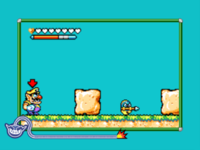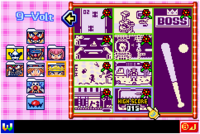Microgame
Microgames are simple minigames appearing in the WarioWare series, and its spiritual predecessor Mario Artist: Polygon Studio.
Mostly created by the fictional company WarioWare, Inc., these games have extremely stripped-down gameplay. Microgames are generally less than 5 seconds long, which is even shorter, and makes the gameplay simpler, than the minigames found elsewhere, such as in the Mario Party series. Gameplay in all WarioWare games is distinct from most other games, as they involve the player trying to beat the microgames as soon as possible. Most games present instructions in the form of a verb and quickly drop the player into the situation where they must perform said verb.
All microgames are strung together in a random order within different "stages," each hosted by a different character. After the player is presented with a quick one or two word instruction (such as "Eat!" or "Rub!"), the microgame appears and the player has to complete the game according to the instruction. The microgames usually have only one task to complete; for instance, the player may be presented with a scene from The Legend of Zelda and have to move Link to a cave entrance using the directional buttons before time runs out, or they may have to drive a car, avoiding oncoming traffic.
Microgames come in three main types, classified by the condition required to clear them. Some games require the player to accomplish a task within a limited amount of time. If they do the action presented, a sound bite plays to signify the game's completion; this is usually heard just before the timer runs out and may continue through the return to the score screen. Other games require the player to instead survive so that something does not happen before the timer runs out, with the sound bite playing after the score screen returns. Finally, there are boss minigames, which always occur at a set point in a channel; these are are usually more challenging, have no time limit, and give chances back upon successful clearing. They are also required to be cleared to pass a channel for the first time. After the fulfillment of the task(s) presented, the sound bite plays, the score screen returns, and on repeated plays, if the player has less than four lives, one will be restored.
Additionally, the WarioWare series features several deviations from the normal classifications of microgames. There are IQ-genre games, which last twice as long to fit their brain-stretching contents; multiplayer microgames, which are used to determine who goes first in a multiplayer game or to settle a tie; and several microgames that require a complete lack of input to complete.
The unit of time for all microgames is beats. In Mega Microgame$! and Twisted!, a standard microgame is 8 beats long (4 seconds, at normal speed), while microgames in the IQ genre, hosted by Orbulon, last 16 beats (8 seconds); the latter length is also used for two games hosted by Wario-Man in Twisted! Also in Twisted!, Fronk microgames are only 4 beats (2 seconds) long and the WarioWatch has a timer for the whole stage rather than each individual microgame. In most games, the BPM starts out relatively slow and then increases as the player completes microgames. The average length of a microgame has been suggested by Nintendo to be five seconds, when in reality it is only four.[1]
To show the time left to complete a microgame, a small "bomb" appears at the bottom of the screen. The fuse and a countdown timer show the amount of time left to complete the microgame. When time runs out, the bomb explodes and in most cases, the player loses a life. The fuse burns faster when the BPM increases. Some microgames are intrinsically harder than others, and an increased BPM (increased speed) will make any microgame more difficult to complete than the same microgame at a slower BPM. This is usually reflected in the microgames' "clear scores"—the score one must reach while playing a microgame in the practice modes to obtain credit for "clearing" it (Smooth Moves lacks this feature, however, as do the exclusive multiplayer microgames from Mega Party Game$!).
Except in D.I.Y., each microgame is featured in three difficulty levels: Blue, Yellow and Red. Blue presents the given task in an easier way, while Red presents it in a much harder way. Not all modes of all WarioWare games actually show a color to denote the current level, but most modes start with Blue games, progressing to Yellow upon a "Level Up" (usually achieved after passing a boss microgame), then to Red in similar fashion. Once Red is reached, sequential "Level Up"s will typically be replaced by "Speed Up"s (an increase in BPM).
In Game & Wario, 22 microgames appear in 9-Volt's "Gamer" minigame, two of which (Gold Digger and Sole Man) return from Mega Microgame$!
Outside of the WarioWare series, microgames are used in the WarioWare, Inc. stage in Super Smash Bros. Brawl and Super Smash Bros. for Nintendo 3DS. If a player wins the microgame, they are rewarded with item effects, including growing (Super Mushrooms) and becoming invincible (Stars). Also, in Mario Party Advance, the term "microgame" is applied to any small challenge given in that game's quests. As such, the microgames there may vary widely in style, purpose, and simplicity; completing a microgame typically rewards the player with a Gaddget.
Lists of microgames
- WarioWare, Inc.: Mega Microgame$! and Mega Party Game$! - 213 microgames
- WarioWare: Twisted! - 223 microgames
- WarioWare: Touched! - 192 microgames (1 returning, 1 Japan-only, 1 localization-only)
- WarioWare: Smooth Moves - 205 microgames
- WarioWare: Snapped! - 20 microgames
- WarioWare: D.I.Y. - 113 microgames (4 returning, 2 Japan-only, 2 localization-only)
- WarioWare: D.I.Y. Showcase - 76 microgames
- WarioWare: D.I.Y./D.I.Y. Showcase downloadable microgames - 138+ microgames (101 Weekly Games, 37+ Big Name Games)
- Game & Wario - 22 microgames (2 returning)
- WarioWare Gold - 316 microgames (262 returning)
Names in other languages
| Language | Name | Meaning |
|---|---|---|
| Japanese | プチゲーム Puchi gemu |
Small game |
| German | Mikrospiel |
Microgame |
| Spanish | Microjuego |
Microgame |
References
- ^ "WarioWare: Touched! at Nintendo :: Games." Nintendo.com. February 14, 2005.

